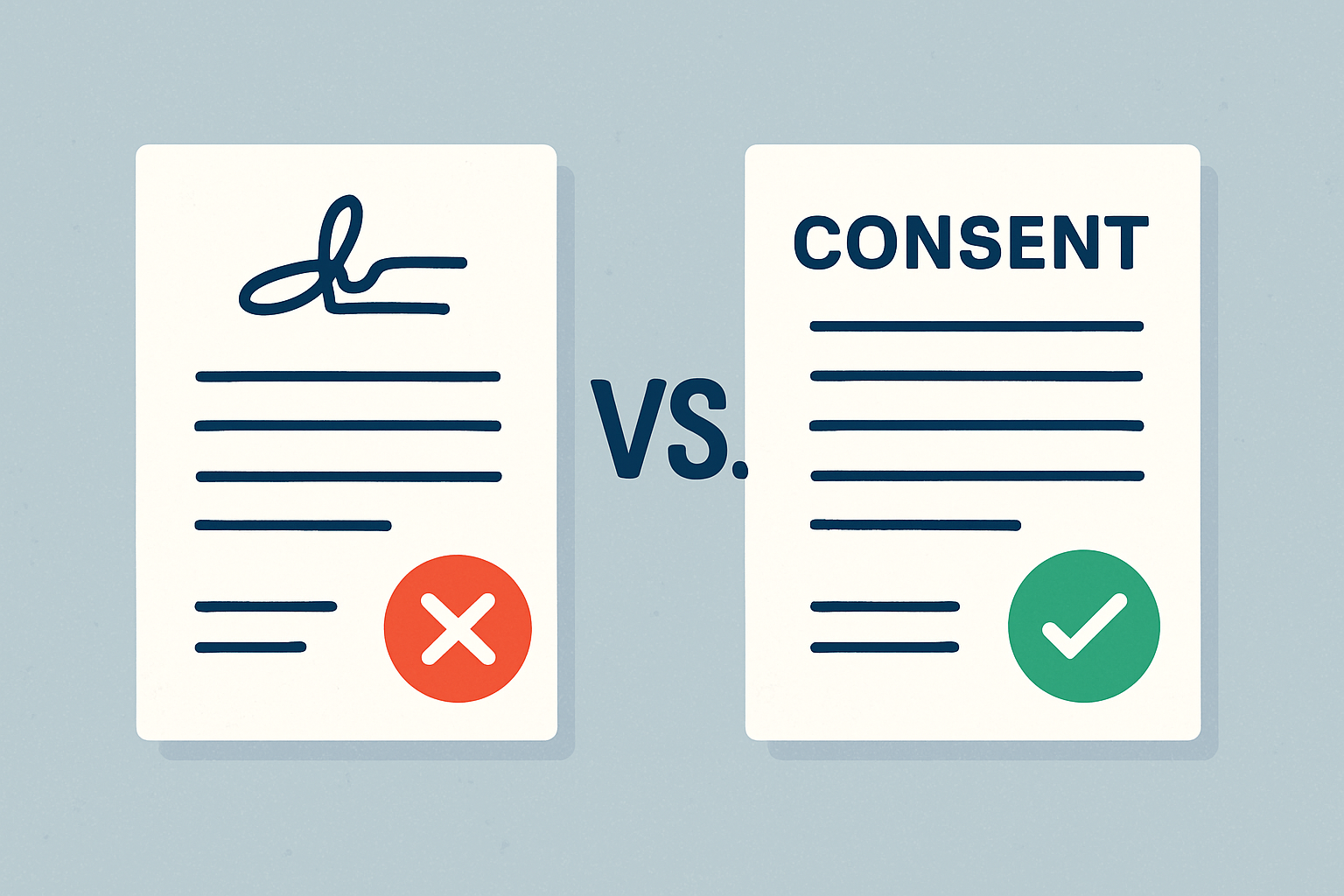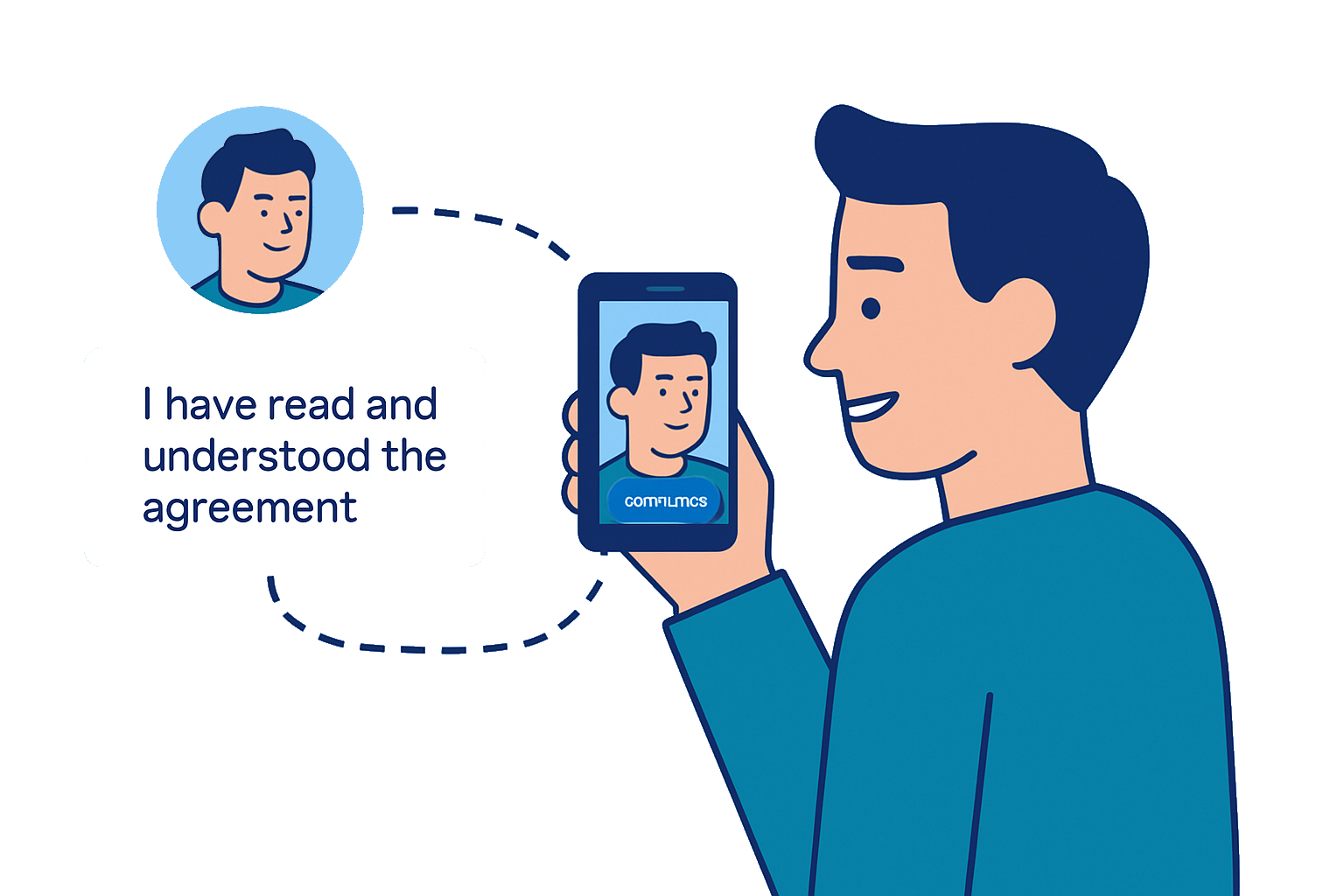Customers now expect digital, fast and human experiences. The same shift that moved shopping to ecommerce and banking to mobile must reach contracts. The future of agreements is about clarity, accessibility and proof that people truly understand what they are agreeing to.
Paper heavy processes and tiny legal text slow people down and increase risk. When information is hard to absorb, customers default to skim and click. That creates avoidable complaints, slow onboarding and poor outcomes. A modern agreement should feel like a conversation, not a hurdle.

A tick or scribble only shows that an action happened. It does not show what a person actually understood. Informed consent vs signature is about capturing intent, comprehension and a clear acceptance of the key points. That is what reduces disputes and builds confidence for both sides.
When teams present the essentials in plain language and ask for a short confirmation, the quality of acceptance improves. You can demonstrate that people heard the important bits, had a chance to ask questions and chose to proceed. That evidence carries more weight than a box that was clicked in haste.
Voice consent and video consent in the UK give you a natural way to confirm agreement. A short audio or selfie video clip captures the person, the moment and the message. It provides an audit trail that links the explanation to the acceptance with time, context and identity.
Customers already communicate with voice notes and short videos. Meeting them in that format lowers friction and improves comprehension. Teams benefit from reviews that are quick and objective because the evidence is simple to replay and understand.

Voice consent when speed matters and the script is short
Video consent when you want stronger identity and visual cues
Either format for clarity checks on risks, fees and cancellations
 i agree is a digital agreements platform that replaces walls of text with short lines in plain English and quick explainer videos. Instead of hiding the essentials, it brings them to the surface and records a simple confirmation that they make sense.
i agree is a digital agreements platform that replaces walls of text with short lines in plain English and quick explainer videos. Instead of hiding the essentials, it brings them to the surface and records a simple confirmation that they make sense.
You capture voice or video consent with timestamps, the display of key terms and the sequence of steps taken. Teams get templates, guidance and reports so quality stays consistent. Compliance teams can search, filter and produce evidence in minutes, not days.
Clear summaries that highlight the big points
Short media explainers that people replay on any device
Consent capture that is guided, consistent and recorded
Plain English contracts and accessible agreements help everyone, not just legal experts. People decide faster when information is chunked, ordered by importance and written in familiar words. This approach improves inclusion for customers with varied literacy levels or those reading on small screens.
Accessibility is not an extra, it is the core of a fair process. Use headings that map to real questions, break complex ideas into steps and provide audio or video versions for the same content. When people can choose their format, understanding goes up and complaints go down.
Replace jargon with everyday words and short sentences
Use lists for fees, risks and timelines
Offer text, audio and video for the same message
If you work in FCA or SRA regulated firms, you need consent evidence that shows more than a checkbox. Record how the key points were explained, show that the customer heard them and capture a clear acceptance. That creates useful evidence for file checks and complaint handling.
Centralised records make life easier. You can trace the journey from explanation to consent, see who delivered the message and confirm that the right version of the script was used. That level of control supports audits and helps teams demonstrate fair treatment.

Consumer Duty informed consent means communications must be fair, clear and not misleading. It is not enough to publish a long document. You must show that customers could understand the important parts and that you checked for understanding before proceeding.
With  i agree you highlight the material information, present it in plain language and capture a short confirmation that it makes sense. If someone hesitates or asks a question, the flow guides the user to pause, clarify and try again. That reduces poor outcomes and speeds up resolution when issues arise.
i agree you highlight the material information, present it in plain language and capture a short confirmation that it makes sense. If someone hesitates or asks a question, the flow guides the user to pause, clarify and try again. That reduces poor outcomes and speeds up resolution when issues arise.

Trust grows when your process is transparent and human. People want to feel that a business respects their attention and explains the essentials without pressure. When you do that, you lower anxiety and make it easier for customers to say yes with confidence.
Trust also protects revenue. Clear expectations mean fewer surprises and better fit customers. When problems do appear, you have evidence that shows what was explained and agreed, which helps everyone find a fair outcome faster.
The next generation expects everything to work on their phone, to be explained in short video or simple lines, and to allow quick questions in context. They use short videos, voice notes and interactive screens every day, so agreements should feel the same. When you modernise contracts for the next generation you become the brand that understands how people actually live. Speak plainly, show the essentials, and make it easy to ask for clarification.
This audience values authenticity and clarity. If you look like a faceless process, you lose them. Offer a quick video explainer for key terms, allow a voice confirmation, and make it simple to replay the information later. Respect their time with clean screens and short steps that fit into busy lives. When the experience feels natural, completion rates rise and support tickets fall. Design your agreements like a helpful guide and you will win long term loyalty.
Short modules with one clear action per screen
Visual cues for risks, fees and cancellation rules
A friendly tone that sounds like a person, not a policy
 i agree works
i agree works i agree turns agreements into a guided conversation. You start with the essentials, deliver a short explainer in text or video, then capture a voice or video confirmation. The system stores everything in order, so any reviewer can see what happened in seconds.
i agree turns agreements into a guided conversation. You start with the essentials, deliver a short explainer in text or video, then capture a voice or video confirmation. The system stores everything in order, so any reviewer can see what happened in seconds.
Teams use templates with approved lines, which makes the process consistent. Managers can see where people pause, which lines trigger questions and where scripts need refinement. Over time the whole experience becomes clearer and faster.
Yes. Consent can be valid without a handwritten signature when there is clear evidence of what was agreed and by whom. Voice consent is a practical way to capture that evidence because it records the words used, the person speaking and the time of acceptance. For best results, pair the recording with a clear script and a record of what was shown on screen.
Yes. Video consent can form part of a valid agreement when it records the explanation and the acceptance. It helps with identity and context because reviewers can see the person, the terms being referenced and the moment of acceptance. Store the clip with a link to the exact lines or summary that were presented.
A signature shows that someone completed an action. Informed consent shows that the person understood what mattered and then chose to proceed. With  i agree you present the essentials in plain English, then capture a short voice or video confirmation that proves understanding.
i agree you present the essentials in plain English, then capture a short voice or video confirmation that proves understanding.
 i agree replace electronic signatures?
i agree replace electronic signatures?
In many use cases a signature is not required for a contract to be binding. Where policy still calls for a signature, you can keep it as a final step and use voice or video to evidence understanding. This keeps compliance happy and gives customers a more human experience.
 i agree help with Consumer Duty?
i agree help with Consumer Duty?
It helps you prove that communications are fair and clear. You can show that material information was highlighted, that customers confirmed understanding and that the firm paused to clarify when needed. This supports better outcomes and faster complaint resolution.
People can choose text, voice or video. Content is written in plain English with clear structure and readable contrast. This supports customers with different needs and preferences and reduces the need for follow up calls.
 i agree work best?
i agree work best?
Financial services, legal services, health and care, high value sales and SaaS onboarding. Any process where clarity and proof of understanding matter will benefit. Teams see gains in speed, first time completion and satisfaction.
Pick one of your agreements, upload it, and we’ll do the heavy lifting. We’ll turn it into a clear summary that will be used to create a short explainer that covers the essentials. All you need to do is review the result and make sure you’re happy. Try sending it to yourself to see how it works in practice. If you need templates, training, or integrations, we’re here to help.
If you have more questions, take a look at our full FAQs page where we cover a wider range of topics in more detail. It’s a quick way to find answers and explore other subjects that might be useful to you.


